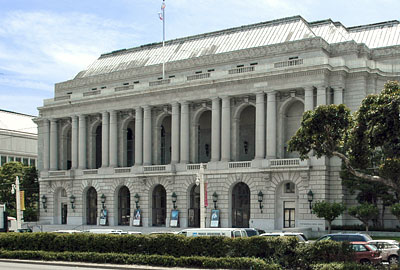San Francisco Landmarks
War Memorial Complex
301 Van Ness and 401 Van Ness
Built 1932
The War Memorial Complex is composed of two substantially identical structures, the Opera House and the Veterans Building, separated by a formal court, conceived to complement and enhance City Hall on the opposite side of South Van Ness Avenue.

In April 1918, twelve years after the City had experienced the loss of its major theaters, halls and opera houses, a group of prominent San Franciscans, members of the Musical Association, met to consider construction of a hall for performing arts. A previous attempt in 1911 and 1912 by the group had been thwarted by a state Supreme Court decision that the City could not contribute the land for what was to be essentially a privately owned building. Although new theaters and the Civic Auditorium had been constructed after 1906, none provided the facilities or setting deemed appropriate by the local citizenry which had given opera and other cultural events widespread and enthusiastic support since the City's first operatic performance in 1851.
The 1918 meeting was the genesis of what was to become the War Memorial.
November 1918 saw the end of World War I and the return of servicemen to their homes. Among those returning to San Francisco was Major Charles H. Kendrick who conceived the idea of combining the performing hall with the growing demand throughout the nation for memorials commemorating the war heroes. His idea was enthusiastically accepted by the Association which was purchased property on Van Ness Avenue where St. Ignatius Church and College stood before the 1906 Earthquake and Fire.
In October 1922, a distinguished Architectural Advisory Committee was appointed; chaired by Bernard Maybeck, it included Willis Polk, John Galen Howard, Ernest Coxhead, G. Albert Lansburgh, John Reid Jr., Fred Meyer and Arthur Brown Jr. - a veritable Pantheon of Bay Area architects. In January 1923, the War Memorial Trustees, announced that they would erect the following buildings: Opera House, American Legion Building and Art Museum. The architects selected were Arthur Brown Jr. and G. Albert Lansburgh who had achieved recognition for his theater design.
Foundation work commenced on January 28, 1931. The cornerstones were laid on Armistice Day, 1931. The complex was dedicated on Admission Day, September 9, 1932.
Maestro Gaetano Merola, had performed in San Francisco with touring opera companies as early as 1906. In 1921, he moved to San Francisco to organize an opera company while construction funds were being solicited from the public. In April 1923, the San Francisco Opera Association was formally organized, and the first season of the company opened on September 26, 1923 in the Civic Auditorium which had been temporarily revamped to suggest an opera house. By 1924, the Association had over 2,000 founders pledged to underwrite any future production deficits.
The Opera House opened on Saturday evening, October 15, 1932, with a performance of Puccini's La Tosca, with Maestro Merola conducting and the great Claudia Muzio in the title role. When it opened, it was the first municipally owned opera house in the world.
Source: Adapted from City Planning Commission Resolution 7273 dated December 5, 1974.

In April, May and June of 1945, with the world well into its sixth year of global war, the two buildings of the War Memorial served as the birthplace of the United Nations. Most of the meetings and ceremonies of the Conference took place in the Veterans Building, but it was on the great stage of the Opera House that President Truman and other heads of state and dignitaries signed the United Nations Charter at a plenary session on June 26, 1945.
Source: Adapted from City Planning Commission Resolution 7273 dated December 5, 1974.

The War Memorial Complex is also California Landmark 964.
